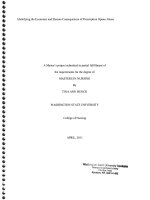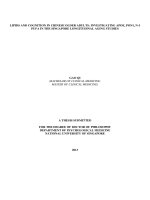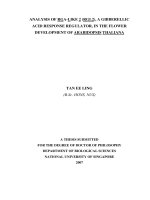FOR THE DEGREE OF DOCTOR OF PHILOSOPHY DEPARTMENT OF PSYCHOLOGICAL MEDICINE NATIONAL UNIVERSITY OF SINGAPORE
Bạn đang xem bản rút gọn của tài liệu. Xem và tải ngay bản đầy đủ của tài liệu tại đây (4 MB, 162 trang )
LIPIDS AND COGNITION IN CHINESE OLDER ADULTS: INVESTIGATING APOE, PON1, N-3
PUFA IN THE SINGAPORE LONGITUDINAL AGING STUDIES
GAO QI
(BACHELOR OF CLINICAL MEDICINE;
MASTER OF CLINICAL MEDICINE)
A THESIS SUBMITTED
FOR THE DEGREE OF DOCTOR OF PHILOSOPHY
DEPARTMENT OF PSYCHOLOGICAL MEDICINE
NATIONAL UNIVERSITY OF SINGAPORE
2013
I
ACKNOWLEDGEMENTS
I am most grateful to my knowledgeable and dedicated supervisor, Professor Ng Tze Pin. I wish to express
my sincere appreciation for the kindness he has always shown towards me and for the excellent methods of
his teaching which make PhD study a real pleasure. I always remember what he said when I first met him on
22 July 2008: think big, dig deep, start small and act fast. It would be impossible for me to complete this
PhD thesis without his expertise, encouragements, and concrete helps.
I also would like to thank Dr Philip Yap and the staff at the Geriatric Clinic KTPH (previously known as the
Memory Clinic Alexandra Hospital), for their input and contribution to my research work. My thesis would
not have been completed if not for their friendly and timely assistance.
I wish to express my sincere gratitude to Prof John Wong, the head of Department of Psychological
Medicine. I am deeply grateful for his strong support and encouragement for my thesis writing and
submission.
I would like to give thanks to all the research staffs, research nurses, and the elderly participants of the
Singapore Longitudinal Ageing Study (SLAS), the staffs in the Department of Psychological Medicine
National University of Singapore, for all your helps, supports, and instructions in the past six years.
I would also like to thank to the National University of Singapore, for awarding me the Research
Scholarship in the four-year candidature, thus supporting both my daily life and my thesis work. I sincerely
hope that I could contribute more to Singapore, a dynamic and promising country.
II
Finally, I would express my endless thanks to my parents, my family members and my best friends in China,
United States and Japan, for their unconditional love, heartening words and encouragements during my
lonely and hard times. Especially thanks to Chun-Wei, for helping make my dreams come true. Thanks for
the touching and beautiful moments. It is the best thing that ever happened in my life.
III
CONTENTS
DECLARATION PAGE
I
ACKNOWLEDGEMENTS
II
SUMMARY
VII
LIST OF TABLES
IX
LIST OF FIGURES
XI
LIST OF ABBRIVIATIONS
XII
LIST OF APPENDICES
XV
1. INTRODUCTION
1
1.1 Aging population
1
1.2 Cognitive decline and dementia in the elderly
1
1.3 Risk and protective factors in cognitive decline and dementia
3
1.4 The role of lipids in elderly cognition
4
1.5 Objectives of the current study
6
2. LITERATURE REVIEW
7
2.1 n-3 PUFAs and cognition in the elderly
7
2.1.1 Cardiovascular protective mechanisms of n-3 PUFAs
7
2.1.2 Neuroprotective mechanisms of n-3 PUFAs
8
2.1.3 Cross-sectional studies
8
2.1.4 Prospective cohort studies
10
2.1.5 Clinical Trials
12
2.2 APOE and cognition in the elderly
15
2.2.1 APOE gene polymorphism
16
IV
2.2.2 Neurobiological role of APOE
17
2.2.3 APOE and AD
18
2.2.4 APOE and VaD
20
2.3 PON1 gene 192 Q/R polymorphism and cognition in the elderly
21
2.3.1 PON1 and its biological activities
21
2.3.2 PON1 gene 192 Q/R polymorphism and dementia
22
3. METHODS
24
3.1 Study population
24
3.1.1 Community-based
24
3.1.2 Clinical-based
27
3.2 Study design and Sample size
28
3.2.1 Study I
28
3.2.2 Study II
28
3.2.3 Study III
29
3.2.4 Study IV
29
3.2.5 Study V
29
3.3 Outcome measurements
30
3.3.1 Cognitive performance
30
3.3.2 Clinical manifestations and disease severity of dementia
33
3.3.3 Omega-3 intake
34
3.3.4 APOE and PON1 genotyping
35
3.3.5 Covariates
37
3.4 Statistical analysis
38
3.4.1 Study I
38
3.4.2 Study II
39
V
3.4.3 Study III
39
3.4.4 Study IV
40
3.4.5 Study V
40
4. RESULTS AND DISCUSSION
41
4.1 Study I
41
4.1.1 Results
41
4.1.2 Discussion
44
4.2 Study II
47
4.2.1 Results
47
4.2.2 Discussion
56
4.3 Study III
61
4.3.1 Results
61
4.3.2 Discussion
66
4.4 Study IV
69
4.4.1 Results
69
4.4.2 Discussion
79
4.5 Study V
82
4.5.1 Results
82
4.5.2 Discussion
93
5. SUMMARY AND CONCLUSION
97
REFERENCES
101
LIST OF PUBLICATIONS
127
LIST OF CONFERENCE PRESENTATIONS
128
APPENDICES
129
VI
SUMMARY
Background: A number of lipids function as protective or risk factors in human cognition. Published
findings are inconsistent and/or insufficient. Few data are available for Asian population.
Objective: To examine the relationship of APOE ε4, PON1 polymorphism and n-3 PUFA and cognition
(cognitive performance, cognitive decline and dementia) in elderly Chinese Singaporeans.
Methods: The study subjects were recruited from two sources: (1) Chinese participants in the Singapore
Longitudinal Ageing Study-1 (SLAS-1) and (2) Chinese patients with confirmed diagnosis of dementia from
Alexandra Hospital. Study I investigated the association of n-3 PUFA supplements intake with cognitive
decline. Study II investigated the association of n-3 PUFA supplements intake and cognitive performance.
Study III investigated the association of APOE ε4 allele and dementia. Study IV investigated the PON1
gene 192Q/R polymorphism and its association with clinical manifestations and disease severity of dementia
among patients with AD and mixed dementia. Study V investigated the association between PON1 gene
192Q/R polymorphism and the risk of dementia and the interaction between APOE ε4 status and PON1 gene
192Q/R polymorphism.
Results: Study I found that daily n-3 PUFA supplements intake was significantly associated with lower risk
of cognitive decline (adjusted OR=0.23, 95% C.I. 0.07-0.75, P=0.015). Study II showed daily intake of n-3
PUFA supplements was independently associated with better cognitive performance on memory (β=0.098,
SE=0.31, P=0.006), executive function (β=0.071, SE=0.43, P=0.046) and information processing speed
(β=0.074, SE=0.24, P=0.036). Study III showed significant differences in the prevalence of APOE ε4 allele
between AD patients and cognitively normal controls (35.6% and 17.2% respectively, P =0.005), Odds ratio
(OR) of the association adjusted for education was 2.41, 95% C.I.1.10-5.28, P=0.028. No significant
VII
association of APOE ε4 allele with VaD/mixed dementia was found. Study IV found that the PON1 R allele
was significantly associated with more neuropsychiatric symptoms among dementia patients overall. In the
mixed dementia subgroup, the R allele was significantly associated with three fold increased NPI(S) scores
(9.01 versus 3.11, P=0.039) and NPI (CD) scores (9.09 versus 2.33, P=0.006), CDR (sum of boxes) score
(8.57 versus 5.89, P=0.042), GDS/FAST score (4.84 versus 4.11, P=0.007) and BADLS score (6.99 versus
1.00, P<0.001). Study V showed that the total distribution of PON1 192Q/R genotype was significantly
different between non-AD dementia and matched controls (29 R/R, 33 Q/R, 4 Q/Q; 32 R/R, 22 Q/R, 12 Q/Q
respectively, P=0.042), and the presence of at least one R allele (R/R or Q/R) was significantly different
(93.9 % and 81.8% respectively, P=0.033). Among APOE ε4 non-carriers, the presence of at least one R
allele (R/R or Q/R) was significantly different between non-AD dementia patients and matched controls
(95.6% and 80.0% respectively, P=0.024). However, we did not find a significant association between
PON1 gene 192Q/R polymorphism and the risk of AD/non-AD dementia.
Conclusions:
These studies indicated that multiple risk and protective factors related to lipid metabolism are involved in
cognitive decline and dementia. The complex relationships between lipid related factors, cognitive decline
and dementia should be recognized and investigated systematically in future research.
VIII
LIST OF TABLES
Study I
1. Baseline characteristics of study participants
42
2. Association between daily intake of omega-3 PUFA supplements
and cognitive decline
43
Study II
3. Baseline descriptions of the study participants, for whole sample
and by intake of omega-3 PUFA supplements
49
4. Cognitive performance of the whole study participants
50
5. Cognitive performance of the study participants by intake of
omega-3 PUFA supplements
52
6. Association between daily intake of omega-3 PUFA supplements
and cognitive performance
54
Study III
7. APOE ε4 allele status in dementia patients (n=153)
62
8a. APOE ε4 allele distribution in dementia cases and controls
63
8b. Association of APOE ε4 allele and dementia
63
9a. APOE ε4 allele distribution in AD cases and controls
64
9b. Association of APOE ε4 allele and AD
64
10a. APOE ε4 allele distribution in non-AD cases and controls
65
10b. Association of APOE ε4 allele and non-AD
65
Study IV
11. Demographic characteristics of the study population (n=186)
70
12. PON1 192Q/R genotype distributions and allele frequencies
in the study population
71
13a. Clinical manifestations and severity of patients with dementia
by PON1 192Q/R genotypes
72
IX
13b. Prevalence of neuropsychiatric symptoms of patients with dementia
by PON1 192Q/R genotypes
73
14a. Clinical manifestations and severity of patients with dementia
by PON1 gene 192Q/R allele status and among dementia subtypes
75
14b Prevalence of neuropsychiatric symptoms of patients with dementia
by PON1 gene 192Q/R allele status and among dementia subtypes
77
Study V
15a. PON1 192Q/R genotype distribution and allele frequencies
in AD cases and controls, stratified by APOE ε4 allele status
83
15b. PON1 192Q/R genotype distribution and allele frequencies in
non-AD cases and controls, stratified by APOE ε4 allele status
85
16a. Association of PON1 gene 192 Q/R polymorphism and AD
87
16b. Association of PON1 gene 192 Q/R polymorphism and non-AD
88
17a. Association of PON1 gene 192 Q/R polymorphism and AD,
stratified by APOE ε4 status
89
17b. Association of PON1 gene 192 Q/R polymorphism and non-AD,
stratified by APOE ε4 status
91
X
LIST OF FIGURES
Figure 1: Chemical structure of ALA, EPA and DHA
7
Figure 2: Description of participants in the Singapore Longitudinal
Ageing Study-1 (SLAS-1)
26
XI
LIST OF ABBREVIATIONS
APOE: Apolipoprotein E
AA: Arachidonic acid
Aβ: Amyloid-β
AD: Alzheimer’s disease
ADAS: Alzheimer’s Disease Assessment Scale
ADL: Activities of Daily Living
ALA: α-linolenic acid
BADL: Bristol Activities of Daily Living
BADLS: Bristol Activities of Daily Living Scale
BMI: Body Mass Index
CAD: Coronary artery disease
CDR: Clinical Dementia Rating
ChEI: Cholinesterase inhibitor
CI: Confidential interval
COPD: Chronic obstructive pulmonary disease
CVA: Cardiovascular accident
DHA: Docosahexaenoic acid
DNA: Deoxyribonucleic acid
DSM-IV-TR: Diagnostic and Statistical Manual for Mental Disorders, Fourth Edition, Text Revision
EOAD: Early-onset Alzheimer’s disease
EPA: Eicosapentaenoic acid
FAST: Functional assessment staging
GDP: Gross domestic product
XII
GDS: Geriatric Depression Scale
GDS: Global Deterioration Scale
HDL: High-density lipoprotein
IADL: Instrumental Activities of Daily Living
IDL: Intermediate-density lipoprotein
LDL: Low-density lipoprotein receptor
LDLR: Low-density lipoprotein receptor
LOAD: Late-onset Alzheimer’s disease
LRP: LDL receptor-related protein
MCI: Mild cognitive impairment
MMSE: Mini-Mental State Examination
N-3 PUFA: Long chain omega-3 polyunsaturated fatty acid
NINCDS-ADRDA: National Institute of Neurological and Communicative
Diseases and Stroke/Alzheimer’s Disease and Related
Disorders Association
NINDS-AIREN: National Institute of Neurological Disorders and Stroke and
Association Internationale pour la Recherche et
I’Enseignement en Neurosciences
NFT: Neurofibrillary tangles
NPI: Neuropsychiatric inventory
NPI-Q(S): Neuropsychiatric inventory questionnaire (symptoms)
NPI-Q(CD): Neuropsychiatric inventory questionnaire (caregiver distress)
OR: Odds ratio
PCB: Polychlorinated biphenyl
PCR: Polymerase chain reaction
XIII
PON1: Paraoxonase 1
PON1a: Paraoxonase 1 activity
RVALT: Rey Auditory Verbal Learning Test
SAD: Sporadic Alzheimer’s disease
Symbol Digit Modalities Test (SDMT)
TG: Triglyceride
VR: Visual Reproduction
VLDL: Very low-density lipoprotein
XIV
LIST OF APPENDICES
Appendix 1: SLAS Mini-Mental State Examination
Appendix 2: Gao Q, Niti M, Feng L, Yap KB, Ng TP. Omega-3 polyunsaturated fatty acid supplements and
cognitive decline: Singapore Longitudinal Aging studies. J Nutr Health Aging. 2011;15(1):32-5.
Appendix 3: Sachdev PS, Lipnicki DM, Kochan NA et al. COSMIC (Cohort Studies of Memory in an
International Consortium): An international consortium to identify risk and protective factors and
biomarkers of cognitive ageing and dementia in diverse ethnic and sociocultural groups. BMC Neurol.
2013;13(1):165.
XV
CHAPTER 1 INTRODUCTION
Poor cognitive functioning and dementia are highly prevalent in ageing populations. Because no effective
cure is available, it is of major importance to identify risk and protective factors in order to prevent cognitive
decline and delay the onset of dementia. Common known factors include age, gender, ethnicity, education
level, smoking, use of drug, alcohol consumption, cardiovascular factors (e.g. hypertension, diabetes, heart
disease and stroke), nutrition (e.g. anti-oxidants and micronutrients), Apolipoprotein (APOE) genotype,
body mass index (BMI), physical, social and productive activities (1). In particular, several lines of evidence
suggest that dysregulated lipid metabolism may influence cognitive functioning (e.g. high cholesterol, statin
use and APOE genotype) (2). The thesis focused on the relationship between APOE ε4, PON1 gene
polymorphism and n-3 PUFA and cognition (including cognitive performance, cognitive decline and
dementia) in elderly Chinese Singaporeans. The general background and context of current study is covered
in Chapter 1. Chapter 2 presented a detailed literature review.
1.1 Population aging
With rising life expectancy and declining fertility rates, the world’s population is ageing rapidly. It is
expected that the number of persons aged 65 and above will triple from 524 million in 2010 to 1.5 billion in
2050 (3-4). In Singapore, one of the fastest ageing populations in Asia, the proportion of residents aged 65
and above increased from 7.2% in 2000 to 9.3% in 2011 and this will rise to 19% in 2030. Furthermore, by
2050, Singapore is projected to be the fourth demographically oldest country in the world (5).
1.2 Cognitive decline and dementia in the elderly
As the elderly population increases, there is growing interest in understanding the changes in cognition
during the aging process. Neuroscientists generally view the cognitive changes as a continuum from normal
aging changes to mild cognitive impairment (MCI) to stages of dementia. It has been found that age is the
most important risk factor for dementia (6-14). Studies have shown that both the prevalence and incidence
1
of dementia double with every five year increase in age. It is estimated that there were 35.6 million people
living with dementia worldwide in 2010, increasing to 65.7 million by 2030 and 115.4 million by 2050 (15).
The total number of new cases of dementia each year worldwide is nearly 7.7 million, implying one new
case every four seconds. In Singapore, the number of demented elderly aged 65 years and above was 22,000
and will reach 53,000 by 2020 and by 2050 the projected figure will further increase to 187,000 with
prevalence rate 18.7% (16).
With the high prevalence and incidence worldwide, cognitive decline and dementia in the elderly has
become a major public health priority. It is associated with a loss of independent function which not only
affects individuals but also caregivers, family members, the healthcare system and society as a whole.
Dementia is a clinical syndrome characterised by a cluster of symptoms and signs manifested by decline in
memory, disturbances in language, psychological and psychiatric changes, and impairments in activities of
daily living (17-18). Late-onset Alzheimer’s disease (AD) and vascular dementia (VaD) are the two leading
forms of dementia. AD often occurs with VaD, resulting in mixed dementia. AD is widely reported to be
predominate, and this has also been shown in older (over 70 years) Singaporeans with dementia (where 60%
were AD cases), but in those aged 50 to 69 years, 65% of dementia cases are VaD (19).
Dementia is one of the main causes of disability in later life. It contributes 11.9% of the years lived with
disability due to a non-communicable disease; higher than stroke (9.5%), musculoskeletal disorders (2.4%),
heart disease (5%), and all forms of cancer (2.4%) (20-21). It is also the leading cause of dependency (i.e.
need for care) and disability among people aged ≥60years in both high-income countries and low- and
middle-income countries.
2
Dementia has significant social and economic impacts in terms of direct medical costs, direct social care
costs and the costs of informal care. In 2010, the total estimated global societal costs of dementia were US$
604 billion, which corresponds to 1.0% of the aggregated worldwide gross domestic product (GDP), or 0.6%
if only direct costs are considered (22).
With the large number of people suffering from dementia and the high socio-economic cost of dementia, it is
overwhelming for the families of affected people and for their caregivers. Physical, emotional and economic
pressures can cause great stress to families and caregivers, and adequate support is required from the health,
social, financial and legal systems.
At present, no treatments are available to cure or even alter the progressive course of cognitive decline or
dementia, although numerous novel therapies are being investigated at various stages of clinical trials.
Therefore, it is of great importance to identify risk and/or protective factors for potential early prevention
and intervention.
1.3 Risk and protective factors in cognitive decline and dementia
Previous research has explored a number of established and putative risk and protective factors for cognitive
decline and dementia. Some factors are immutable, such as age, gender, ethnicity and APOE ε4 allele. On
the other hand, some factors are potentially modifiable, e.g. vascular factors (hypertension, type 2 diabetes
mellitus, stroke, hyperlipidemia), hyperhomocysteinemia, hyperthyroidism, sex hormone levels, depression,
lifestyle factors (e.g. diet, wine, activity, smoking, exposure to toxins and head trauma), drug exposure (e.g.
lipid-lowering agents, nonsteroidal anti-inflammatory drugs, benzodiazepines, vaccinations), education and
occupation (23). In addition, findings from the Singapore Longitudinal Aging Study (SLAS) have suggested
that dietary intake of foods rich in anti-oxidant or anti-inflammatory phytochemicals present in turmeric or
3
tea were associated with lower risks of cognitive impairment and decline in non-demented Chinese older
adults (24-25).
1.4 The role of lipids in elderly cognition
Lipids constitute a broad group of molecules that include fats, waxes, sterols, fat-soluble vitamins (e.g.,
vitamins A, D, E, and K), monoglycerides, diglycerides, triglycerides, phospholipids, and others (26). Their
biological functions are mainly concerned with energy storage, molecular signaling and as structural
components of cell membranes (27). There is growing evidence that some lipids (e.g., cholesterol,
triglycerides, n-3 polyunsaturated fatty acids such as docosahexaenoic acid and eicosapentaenoic acid, and
apolipoprotein A, C and E) could play roles in cognitive decline of degenerative (AD) or vascular origin
(VaD) in the elderly population and may be modifiable risk/protective factors (28-30).
Long chain omega-3 polyunsaturated fatty acids (n-3 PUFAs)
N-3 PUFAs constitute 60% of the membrane fatty acids in neurons. The potential benefits of n-3 PUFAs,
primarily eicosapentaenoic acid (EPA, C20:5n-3) and docosahexaenoic acid (DHA, C22:6n-3) in slowing
cognitive decline in non-demented individuals or reducing thre risks of dementia is of great scientific and
public health interest. Epidemiological studies suggest that n-3 PUFA could be protective against cognitive
decline or dementia (28, 31-34). However, the evidence is based on limited studies and not unequivocal,
possibly due to unaccounted sources of n-3 PUFAs and differences in outcome measurement. Dietary
assessment of fish consumption or total n-3 PUFAs intake are various in different populations according to
the level and type of fish intake and preparation, and other sources of n-3 PUFAs (35-38). The use of
supplements is an important source of n-3 PUFAs but no previous observational studies have reported its
association with cognitive decline, because the use of these supplements was considered to be very low in
the general population (39). In addition, the screening measurements and criteria that used to define
cognitive decline and dementia differ between studies. To date, few studies use a full battery of
4
neurocognitive tests, other than the Mini-Mental State Examination (MMSE), to measure cognitive
performance. This aspect has received scant research attention.
Apolipoprotein E (APOE)
APOE is a key lipoprotein regulating the transport of cholesterol and the metabolism of lipoprotein particles
(41-42). The ε4 allele of APOE is the only confirmed genetic risk factor for AD (40). The interaction of
APOE and the low-density lipoprotein (LDL) receptor determines the homeostasis of cholesterol and
triglycerides (43-44). However, variability in the strength and type of association between Alzheimer's
disease and APOE polymorphisms among ethnic groups has been reported. The association of APOE 4
allele with Alzheimer’s disease or non-AD dementia was weaker for African-Americans than for Hispanics
and whites, and was not found in native Nigerians, whereas the APOE 2 / 3 genotype was associated with
an increased risk of AD in African-Americans (45-47). The association of APOE 4 allele with vascular
dementia (VaD) is still controversial (48). The strength of association of the APOE 4 allele with different
types of dementia in Singapore is unknown. Genetic polymorphism is therefore linked in a complex way
with other genetic and environmental risk factors for dementia.
Paraoxonase 1 (PON1)
APOE ε4 allele is neither necessary nor sufficient for AD (47), implying that other genes may be involved in
the risk of developing AD. The human paraoxonase 1 (PON1), a potent cholinesterase inhibitor, participates
in the prevention of LDL peroxidation, which is thought to be the mechanism by which high-density
lipoprotein (HDL) exerts its anti-atherogenic activity (49-51). At present, there have been inconsistent
reports of the relationship between the PON1 gene polymorphism at 192 Q/R and AD or VaD risk. Apart
from three case-control studies conducted in China and Japan (52-54), there have been no other studies in
Asia on the PON1 gene polymorphism in demented patients. Furthermore, no studies of patients with AD
5
and VaD have examined the effect of PON1 genetic polymorphism on the clinical manifestations and
disease severity.
1.5 Objectives of the current study
The thesis focuses on aspects of the relationship between APOE 4, PON1 192Q/R gene polymorphism and
n-3 PUFA with cognition (including cognitive performance, cognitive decline, and dementia) in elderly
Chinese Singaporeans. Accordingly, five studies were conducted and the objectives are as follows:
Study I: To examine the association between n-3 PUFA supplements intake and cognitive decline in a
community-dwelling elderly Chinese Singaporean population without dementia.
Study II: To examine the association between n-3 PUFA supplements intake and cognitive performance in a
community-dwelling elderly Chinese Singaporean population without dementia.
Study III: To examine the strength of association between APOE ε4 and dementia in Singaporean Chinese.
Study IV: To examine PON1 gene 192Q/R polymorphism and its association with clinical manifestations
and disease severity of Alzheimer’s disease and mixed dementia in Singaporean Chinese.
Study V: To examine (1) the association between PON1 gene 192Q/R polymorphism and dementia and (2)
the interaction between APOE ε4 and PON1 192 Q/R genotypes in Singaporean Chinese
6
CHAPTER 2 LITERATURE REVIEW
2.1 n-3 PUFAs and cognition in the elderly
The n-3 fatty acids are a class of polyunsaturated fatty acids that includes three nutritionally important types:
α-linolenic acid (ALA), eicosapentaenoic acid (EPA) and docosahexaenoic acid (DHA) (Figure 1).
Figure 1 Chemical structure of ALA, EPA and DHA
18:3, n-3; ALA
20:5, n-3; EPA
22:6, n-3; DHA
On one hand, mammals cannot synthesize ALA so it must be consumed from plant sources such as flax
seed, canola oil, wheat germ, soyabeans and nuts (e.g. walnuts). In human, ALA is elongated to form EPA
and DHA, but this conversion is not more than 0.5% (55-56). On the other hand, EPA and DHA are
predominantly found in fish and seafood, although they can be found in meat and eggs as well.
2.1.1 Cardiovascular protective mechanisms of n-3 PUFAs
Biological studies suggest that n-3 fatty acids have protective effects on the cardiovascular system by
lowering blood pressure, lowering triglyceride (TG) and reducing cardiac death (55). In a meta-analysis of
7
nine prospective studies of incident stroke, there was a dose-response inverse association with increased fish
consumption (57). Therefore, dietary n-3 PUFAs intake may be protective of VaD through their beneficial
effects on reducing these cardiovascular risk factors.
2.1.2 Neuroprotective mechanisms of n-3 PUFAs
The metabolism of ALA, EPA and DHA is different, and epidemiological findings have been inconsistent
on the protective effects among the different types of n-3 PUFAs (58-59).
Since glucose uptake is impaired in AD and >60% of ALA is β-oxidized, Freemantle proposed that the
cognitive benefits of ALA could be due to its alternative source of energy via induction of ketogenesis (6061).
EPA is thought to be protective by inhibition of the linoleic to arachidonic acid (AA) pathway via
competition for the same enzymes involved in desaturation and elongation (62). This decreases the
production of prostaglandins, leukotrienes, and thromboxanes that are activated in AD.
DHA is thought to be the primary neuroprotective n-3 fatty acid in metabolically active brain regions,
including the cerebral cortex, synaptosomes and mitochondria (63-65). It has been found to increase the
density of dendritic spines (66-67) and synaptic proteins (66-68), enhance hippocampal neurogenesis (69),
increase cerebral blood volume (70-71), decrease cholesterol in membranes (72-73), reduce AA and its
metabolites (59,74), reduce the amyloid-β (Aβ) burden, reduce Aβ40 and Aβ42 levels in the hippocampus
(75), reduce tau levels, and reduce phosphorylation and conformational changes in tau (74).
2.1.3 Cross-sectional studies
8
To date, nine cross-sectional studies investigated the association between level of n-3 fatty acids (from
dietary intake, plasma, serum or red blood cells), or fish consumption and dementia, AD, cognitive
impairment or cognitive performance (76-84). Among the nine studies, three studies examining dietary
intake of fatty acids or fish oil showed that dietary intake of fatty acids or fish oil could be associated with
better cognitive performance, and other three studies that examined fish consumption suggested a positive
association between fish consumption and cognitive performance measured by MMSE or a cognitive test
battery. Six of the nine studies investigated the relationship of n-3 PUFAs from serum, plasma or
erythrocytes. Five of these six studies showed that high concentrations of n-3 fatty acids could be associated
with lower risk of AD, dementia, or better cognitive performance. The other one study from Italy used gas
chromatography to determine plasma phospholipid fatty acid composition as a marker of the dietary fat
intake, and suggested that dietary fatty acids are not associated with moderate to severe cognitive
impairment measured by MMSE. Three of the nine cross-sectional studies measured cognitive function by
using a cognitive test battery. In a substudy of the Hordland Health Study (HUSK), a cognitive test battery
including six tests was performed among 2031 community-dwelling elderly subjects in Western Norway:
Kendrick Object Learning Test, Trail Making Test (part A), modified versions of the Digit Symbol Test,
Block Design, Mini-Mental State Examination, and Controlled Oral Word Association Test. The findings
showed that individuals with a diet high in seafood (fish and fish products) had a better cognitive test
performance on all the cognitive tests compared to those with lower intake of fish and fish products (81).
Similar results were found by Kalmijn S et al in 2004. In this study, cognitive performance was assessed by
an comprehensive cognitive test battery that measured memory, psychomotor speed, cognitive flexibility
and overall cognitive function. Consumptions of both marine omega-3 PUFAs (EPA and DHA) and fatty
fish were found to be inversely associated with the risk of overall cognitive impairment and psychomotor
speed (79). In addition, one nested case-control study examined the cognitive performance between fish-oil
users and food supplement nonusers. The assessment of cognitive performance was covered by a full range
of cognitive tests including Raven’s Standard Progressive Matrices, the Rey Auditory Verbal Learning Test,
9









